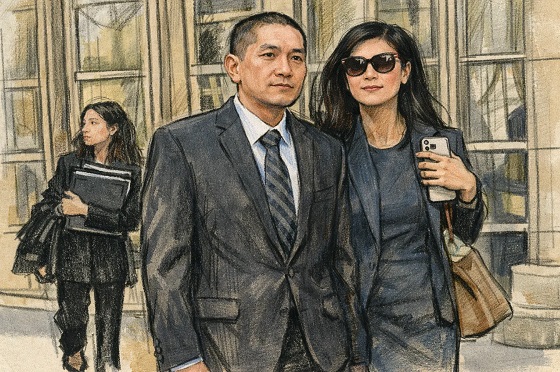Health
Dad says 5-year-old develops autism after being forced to get 18 vaccines in 1 day

From LifeSiteNews
By Michael Nevradakis Ph. D., The Defender
As part of a custody battle, a Tennessee judge ordered a family to vaccinate all three of their children, all of whom had never been vaccinated. Five-year-old Isaac immediately became ill and was eventually diagnosed with severe regressive autism.
In 2016, David Ihben moved his wife and three children from Chicago to Jamestown, in rural Tennessee, with high hopes for a new and calmer life.
But the dream turned into a nightmare for David and his children in December 2019, when divorce proceedings and a subsequent custody battle resulted in the forced vaccination of the children – and changed the family’s fortunes forever.
Ihben said his ex-wife decided “this wasn’t the life she wanted.” So they were attempting to develop a parenting plan in family court – when Tennessee judge Todd Burnett “pulled up the vaccine issue” after discovering the couple’s children were unvaccinated – and forced the parents to vaccinate their children.
Ihben’s two oldest children – daughter Hannah and son Joseph – were spared significant adverse events following their vaccination.
But his youngest son, Isaac, wasn’t so fortunate. After receiving 18 vaccines in one day, Isaac developed severe regressive autism. Today, he requires around-the-clock care.
The children’s mother soon abandoned the children, leaving Ihben to raise them as a single parent – even though he is still obliged to pay child support.
Ihben shared his story with Children’s Health Defense’s (CHD) Vax-Unvax bus. In a subsequent interview with The Defender, he detailed the challenges he faces in caring for Isaac and the harassment he endured from officials in his community. Ihben shared documentation with The Defender verifying his story.
‘How can a judge force medical care without a doctor’s input?’
Ihben told The Defender his entire family was unvaccinated. “I’ve never had any. My dad was drafted by the Army in 1961, and he didn’t get any either. We’ve never vaccinated,” he said. “Our children had to sign religious exemptions for school.”
During divorce proceedings though, his wife’s attorney used the vaccination issue to drive a wedge between the parents.
“When we went to court, I guess her attorney knew that [Burnett] was a pro-vaccine judge and that’s something that they could get me on,” Ihben said.
According to Ihben, Burnett told the couple that it was his “personal opinion that not vaccinating your children is child abuse.” He then told the couple that whichever parent would be willing to vaccinate the children that same day would leave the courthouse with custody.
“I said, ‘Your Honor, we have rights. It’s between the mom and their father,’” Ihben recalled. “Her attorney whispered to her, and she goes, ‘I’ll take them down and vaccinate them today.’”
“I was so surprised, because me and my ex-wife didn’t agree on much, but we did agree on that,” Ihben said, referring to their views on vaccination.
After the hearing, Ihben and his wife were granted joint custody of the children, with their mother as their primary guardian. Later that day, the children received their childhood vaccines – and Isaac immediately became sick.
“My daughter had previous allergies … so the doctor refused to give her all in one day. They split those … She didn’t have any side effects from what I can see,” Ihben said. “[Joseph] was in the ICU for a couple of days but seems to be okay. But [Isaac] spent 12 days in the ICU, eight days with a 106-degree fever.”
Isaac, who was 5 years old at the time, was “just a normal happy kid,” Ihben said.
Today, Isaac has severe regressive autism. Ihben told The Defender:
“He doesn’t talk. He wears a diaper. He eats out of a baby bottle 20-30 times a day, he has speech therapy and will require 24-hour care and supervision for the rest of his life.
“I haven’t had a full night’s sleep in four years. He has to be changed every two hours, or he will have an accident. If you have a child with regressive autism or know someone, you will understand what our days are like.”
Ihben didn’t learn about Isaac’s injuries right away, because the court initially slapped him with a six-month restraining order. When the six months were up, he finally made plans to pick up his children for “two-hour supervised visitation” at a local McDonald’s.
“My youngest comes walking out and I’m like, ‘What’s going on?’” He said his oldest children then told him about what happened to Isaac. “My children told me everything that’s going on. Basically, nobody’s given me information. I had to go off what 10- and 11-year-olds were telling me,” Ihben said.
Ihben tried to find out what happened to Isaac – but encountered more obstacles at Cookeville Regional Medical Center, his local hospital. “The judge had sealed the hospital records. I still cannot get them,” he said.
It wasn’t until he enrolled his daughter in high school that, while obtaining her records from the local health department, he had a chance to view Isaac’s records. That’s when he saw that Isaac had received 18 vaccines in one day.
“How can a judge force medical care without a doctor’s input?” Ihben asked. “I don’t think judges should be dictating medical treatment from the bench.”
According to Ihben, doctors at Vanderbilt University in Nashville said Isaac’s injuries “are a direct result from forced vaccination,” with one doctor telling Ihben that “she’s seen only one other kid that acts like Isaac does.”
Required to continue paying child support, despite mother’s disappearance
Soon after seeing his children for the first time after the custody battle, another surprise was in store for Ihben and his family: Ihben’s ex-wife called to say she and the children had been evicted.
After he kept the children for a week, their mother “got a free house, everything furnished and paid,” and the children were returned to her.
“Then she got evicted from there” in May 2020, Ihben said. He again picked up the children – but that was the last they saw of their mother. According to Ihben, after her second eviction, she left town without a trace.
“We haven’t heard from her or seen her,” Ihben said. “It’ll be five years in May.”
Ihben still pays child support to the state, even though he alone takes care of the children. He said the child support money, which remains uncollected, goes to a state fund – and, if it remains unclaimed, will be confiscated by the state when the children reach adulthood.
Ihben said that though he has gone to court to request full custody of his children or a reduction of his child support payments, he has faced a catch-22 situation.
“The judge said, I can’t do anything unless you get her here in front of me,” Ihben said. “I was like, ‘I’ve served her. Nobody knows where she is.’”
Ihben said he believes the children’s mother didn’t realize Isaac was going to be hurt so badly, and “she just can’t face it.” He added, “I just don’t understand, if she’s been gone almost five years, why she still has full custody, why I still have to pay child support.”
Tennessee laws, local officials pose challenges for raising Isaac
Ihben described the day-to-day realities of caring for Isaac, who will turn 11 next month and just started the fifth grade in a special education program. He said:
“Our lives have changed forever. I can’t have a regular job. I pick up stuff here and there … I have an alarm that goes off every two hours to change Isaac. He eats in the middle of the night … We live out in the country. There’s no bus, so I take him to school back and forth.
“He doesn’t talk, so you don’t know if he’s sick, if he’s upset, if he’s hungry, if he’s cold, if he has a stomach ache … I’ve got a mental list, and I just check it off and hopefully I hit the one that calms him and provides what he needs.”
State rules also pose obstacles. “You’re not allowed to have home healthcare for a disabled child unless you have no other children in the home under 18,” Ihben said.
Ihben noted that Tennessee ranks among the states with the lowest level of funding for autistic children, adding that autistic children are frequently mistreated.
“Our local school district has restraint chairs for autistic children. They are allowed to put Isaac in a chair, to pepper spray him, to tase him. Police departments have no training for dealing with autistic children,” Ihben said.
Ihben said state, county and town officials have attempted to intimidate him and his family.
According to Ihben, the Tennessee Bureau of Investigation (TBI) showed up at his home on Dec. 5, 2023. “Somebody starts beating on the door … there’s a truck at the end of the road, a truck at the end of the other road and two trucks in the driveway. They had assault weapons.”
Ihben said the officers claimed that a social worker wanted to speak with him, but that he refused to open his door for them. He submitted a Freedom of Information Act request to the state to find out why his home was raided, but was told there are “no records of anything.”
The TBI raid took a toll on him. “I had a heart attack that night,” he said. “I couldn’t breathe.” He said the incident still affects him today. “I’m sure I have PTSD from it. I’m still under treatment,” Ihben said.
In June 2023, Ihben said he went to his county commission meeting to tell them about what happened to his family. The county commissioner, Jimmy Johnson, left him a voicemail warning him not to hold any rally or protest.
“The commissioner called the sheriff,” Ihben said, but ultimately “they backed off.”
In another incident, Ihben said he was banned from his local Walmart store after a store manager called the police because Isaac “was causing a disturbance.” This obliged Ihben to shop at another Walmart, an hour away from his home.
Ihben said it’s also difficult to find a lawyer to represent him and his family. “No attorney is willing to take on the judge.”
Local officials ‘tried to scare us’ into not doing Vax-Unvax bus interview
Ihben credited CHD and its Tennessee Chapter for helping him and his family. “We wouldn’t be here without CHD helping us out,” Ihben said. “The Tennessee Chapter has helped us out a lot.”
Ihben said he recently saw “Vaxxed 3” with members of the state’s CHD chapter. “What we have to live through every day is horrible, but it could be worse,” Ihben said, citing stories in the film of children who died post-vaccination.
According to Ihben, his efforts to promote CHD initiatives in his community, such as the visit of the Vax-Unvax bus earlier this year, have also been met with intimidation.
“We put a little flyer together [for the Vax-Unvax bus] and we started passing it out,” Ihben said. But on Feb. 1, the day of his bus interview, Ihben said his wife’s attorney, her husband – who is the attorney for the local school board – and Burnett, who mobilized the TBI, “tried to scare us into not doing the bus interview.”
Getting the word out, spreading the message is ‘the only weapon we have’
Isaac has recently shown some improvement, according to Ihben. “He’s doing better slowly … He’s in a lot of therapy. He’s starting to write some numbers and letters on his own. Teachers think he’s reading, but he’s still never said a word.”
Ihben said this has been a learning experience for his oldest children, who will “have to take care of Isaac every day” after his death. “That’s a lifetime commitment.”
Another silver lining, according to Ihben, is that Isaac’s story has become a learning experience for his family and many members of his local community.
“This hasn’t just got me learning. My kids are learning. Hannah and Joseph are learning about their government and their food and their environment. They’re teaching their friends about this.”
For Ihben, getting the word out and spreading the message is “the only weapon we have.” He said, “It’s powerful that my kids’ friends come up and say ‘we’re sorry for what happened to you, we’ve seen the [Vax-Unvax] interview.’”
Ihben said he hopes the message will help other children avoid Isaac’s fate. “I hope Isaac will be the last,” he said.
This article was originally published by The Defender – Children’s Health Defense’s News & Views Website under Creative Commons license CC BY-NC-ND 4.0. Please consider subscribing to The Defender or donating to Children’s Health Defense.
Alberta
A Christmas wish list for health-care reform

From the Fraser Institute
By Nadeem Esmail and Mackenzie Moir
It’s an exciting time in Canadian health-care policy. But even the slew of new reforms in Alberta only go part of the way to using all the policy tools employed by high performing universal health-care systems.
For 2026, for the sake of Canadian patients, let’s hope Alberta stays the path on changes to how hospitals are paid and allowing some private purchases of health care, and that other provinces start to catch up.
While Alberta’s new reforms were welcome news this year, it’s clear Canada’s health-care system continued to struggle. Canadians were reminded by our annual comparison of health care systems that they pay for one of the developed world’s most expensive universal health-care systems, yet have some of the fewest physicians and hospital beds, while waiting in some of the longest queues.
And speaking of queues, wait times across Canada for non-emergency care reached the second-highest level ever measured at 28.6 weeks from general practitioner referral to actual treatment. That’s more than triple the wait of the early 1990s despite decades of government promises and spending commitments. Other work found that at least 23,746 patients died while waiting for care, and nearly 1.3 million Canadians left our overcrowded emergency rooms without being treated.
At least one province has shown a genuine willingness to do something about these problems.
The Smith government in Alberta announced early in the year that it would move towards paying hospitals per-patient treated as opposed to a fixed annual budget, a policy approach that Quebec has been working on for years. Albertans will also soon be able purchase, at least in a limited way, some diagnostic and surgical services for themselves, which is again already possible in Quebec. Alberta has also gone a step further by allowing physicians to work in both public and private settings.
While controversial in Canada, these approaches simply mirror what is being done in all of the developed world’s top-performing universal health-care systems. Australia, the Netherlands, Germany and Switzerland all pay their hospitals per patient treated, and allow patients the opportunity to purchase care privately if they wish. They all also have better and faster universally accessible health care than Canada’s provinces provide, while spending a little more (Switzerland) or less (Australia, Germany, the Netherlands) than we do.
While these reforms are clearly a step in the right direction, there’s more to be done.
Even if we include Alberta’s reforms, these countries still do some very important things differently.
Critically, all of these countries expect patients to pay a small amount for their universally accessible services. The reasoning is straightforward: we all spend our own money more carefully than we spend someone else’s, and patients will make more informed decisions about when and where it’s best to access the health-care system when they have to pay a little out of pocket.
The evidence around this policy is clear—with appropriate safeguards to protect the very ill and exemptions for lower-income and other vulnerable populations, the demand for outpatient healthcare services falls, reducing delays and freeing up resources for others.
Charging patients even small amounts for care would of course violate the Canada Health Act, but it would also emulate the approach of 100 per cent of the developed world’s top-performing health-care systems. In this case, violating outdated federal policy means better universal health care for Canadians.
These top-performing countries also see the private sector and innovative entrepreneurs as partners in delivering universal health care. A relationship that is far different from the limited individual contracts some provinces have with private clinics and surgical centres to provide care in Canada. In these other countries, even full-service hospitals are operated by private providers. Importantly, partnering with innovative private providers, even hospitals, to deliver universal health care does not violate the Canada Health Act.
So, while Alberta has made strides this past year moving towards the well-established higher performance policy approach followed elsewhere, the Smith government remains at least a couple steps short of truly adopting a more Australian or European approach for health care. And other provinces have yet to even get to where Alberta will soon be.
Let’s hope in 2026 that Alberta keeps moving towards a truly world class universal health-care experience for patients, and that the other provinces catch up.
Health
FDA warns ‘breast binder’ manufacturers to stop marketing to gender-confused girls

From LifeSiteNews
Dr. Marty Makary took aim at the transgender-medical-industrial complex that has exploded in recent years during a recent press conference.
Food and Drug Administration (FDA) commissioner Dr. Marty Makary has sternly warned companies manufacturing “breast binders” to cease marketing and supplying their product to gender-confused girls seeking to make their bodies appear masculine.
“Today the FDA is taking action,” said Makary in a press conference. “We are sending warning letters to 12 manufacturers and retailers for illegal marketing of breast binders for children, for the purposes of treating gender dysphoria.”
“Breast binders are a class one medical device with legitimate medical users, such as being used by women after breast cancer surgery,” but “these binders are not benign,” he cautioned. “Long-term usage has been associated with pain, compromised lung function, and even difficulty breast feeding later in life.”
“The warning letters will formally notify the companies of their significant regulatory violations and require prompt corrective action,” said the FDA head.
.@DrMakaryFDA: “Today the FDA is taking action. We are sending warning letters to 12 manufacturers and retailers for illegal marketing of breast binders for children, for the purposes of treating gender dysphoria.” pic.twitter.com/6JNAy36223
— HHS Rapid Response (@HHSResponse) December 18, 2025
The warning letter addressed to California manufacturer, GenderBender, notes that the company’s website states that “[c]hest binding is the practice of compressing breast mass into a more masculine shape, often done in the LGBTQ community for gender euphoria.”
“Your firm should take prompt action to address any violations identified in this letter. Failure to adequately address this matter may result in regulatory action being initiated by the FDA without further notice. These actions include, but are not limited to, seizure and injunction,” advised the FDA.
During his presentation, Makary took aim at the transgender-medical-industrial complex that has exploded in recent years.
“One of the most barbaric features of a society is the genital mutilation of its children,” observed Makary.
“Pushing transgender ideology in children is predatory, it’s wrong, and it needs to stop,” he declared.
“This ideology is a belief system that some teachers, some pediatricians, and others are selling to children without their parents knowing sometimes, or with a deliberate attempt to remove parents from the decision making,” Makary explained.
To witness society “putting kids on a path of chest binders, drugs, castration, mastectomies, and other procedures is a path that now many kids regret,” he lamented, as he pointed to Chloe Cole, who has reverted to her God-given femininity after undergoing so-called “gender-affirming” surgery as a teen.
Cole is a leading voice for young people who have “detransitioned” after having medically, surgically, and socially attempted to “transition” to a member of the opposite sex.
.@DrMakaryFDA: “Pushing transgender ideology in children is predatory, it's wrong, and it needs to stop.” pic.twitter.com/TXxWNEtNZk
— HHS Rapid Response (@HHSResponse) December 18, 2025
-

 armed forces1 day ago
armed forces1 day agoRemembering Afghanistan and the sacrifices of our military families
-

 Opinion1 day ago
Opinion1 day agoPope Leo XIV’s Christmas night homily
-

 Fraser Institute1 day ago
Fraser Institute1 day agoHow to talk about housing at the holiday dinner table
-

 Frontier Centre for Public Policy1 day ago
Frontier Centre for Public Policy1 day agoTent Cities Were Rare Five Years Ago. Now They’re Everywhere
-

 Fraser Institute18 hours ago
Fraser Institute18 hours agoCarney government sowing seeds for corruption in Ottawa
-

 Alberta18 hours ago
Alberta18 hours agoAlberta Next Panel calls for less Ottawa—and it could pay off
-

 Energy17 hours ago
Energy17 hours agoWhile Western Nations Cling to Energy Transition, Pragmatic Nations Produce Energy and Wealth
-

 International17 hours ago
International17 hours agoNo peace on earth for ISIS: Trump orders Christmas strikes after Christian massacres








